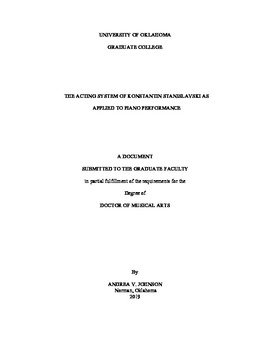| dc.description.abstract | This document presents methods to address common performance challenges faced by college-level piano performance majors by adapting techniques from the acting System of Konstantin Stanislavski, a Russian actor, director, writer, and founder of the Moscow Art Theater (MXAT) who lived from 1863-1938. The common performance challenges addressed in this study are performance anxiety, physical tension in performance, interpretation challenges, and stage presence—the “visual rhetoric” of piano playing. The methods suggested in this study are presented as sixteen Activities that are adapted from Stanislavski’s System for stage actors. Because the impact of Stanislavski’s methods on piano pedagogy is not widely understood, this study also gives background and context for the influence of Stanislavski on a generation of Russian-born and other influential pianists and teachers who became part of the American system of piano pedagogy in the first half of the twentieth century.
Chapter 1 (Introduction) provides support and context for the four performance challenges addressed in the study from writings in the field of piano performance and pedagogy. This chapter also explores the relationship between acting (particularly the methods of Stanislavski) and piano performance through statements and writings by pianists and pedagogues including Theodore Leschetizky, Heinrich Neuhaus, George Kochevitsky, Rosina Lhévinne, Sviatoslav Richter, and Artur Rubenstein. Chapter 2 is a review of literature which examines five intersecting topics: (i) the key writings of Konstantin Stanislavski; (ii) writings about Stanislavski and his System; (iii) key writings on piano performance, skills, and interpretation; (iv) dissertations and theses which propose a connection between the System and music performance; and (v) dissertations and theses which propose connections and applications of the System to fields outside of music.
An overview and selected biography of Stanislavski’s life and work are included in Chapter 3 along with an overview of the Stanislavski’s acting System, outlining what Stanislavski described as a lifelong process of learning and implementing his theory of performance. Following this, chapter 4 presents sixteen specific Activities adapted for college-level pianists which address performance challenges using concepts from the System such as relaxation, public solitude, attention, round-table analysis, imagination, subtext, emotion memory, communication, stage charm, and creating a score of physical actions. This document concludes with chapter 5 which provides a summary, reflections by the author on important aspects of the System and the Activities as well as recommendations for further study. This document also contains a bibliography and appendices including a glossary of key terms. | en_US |

